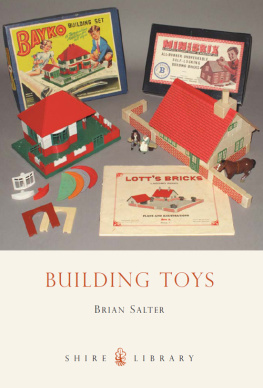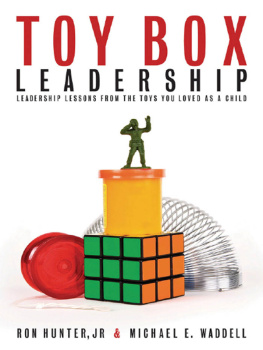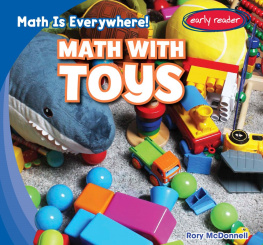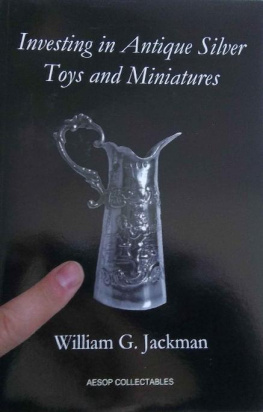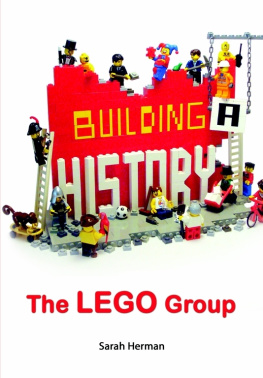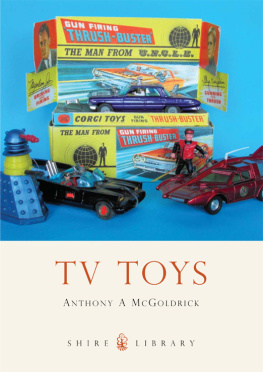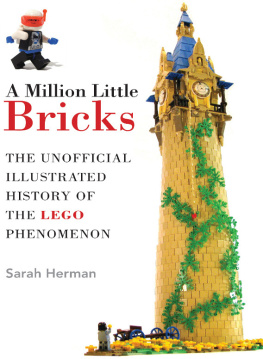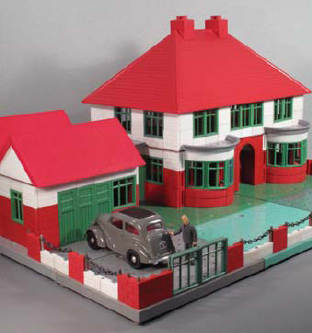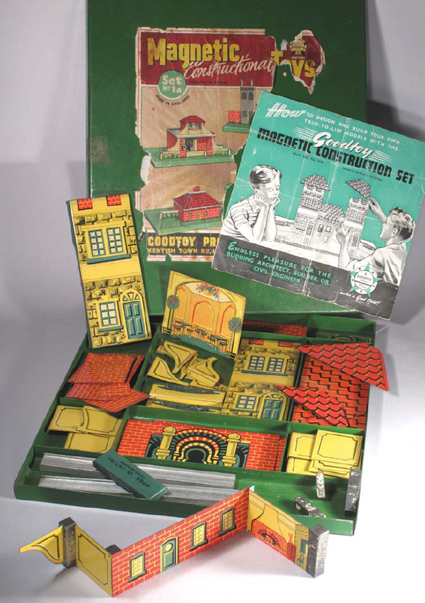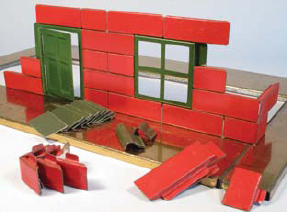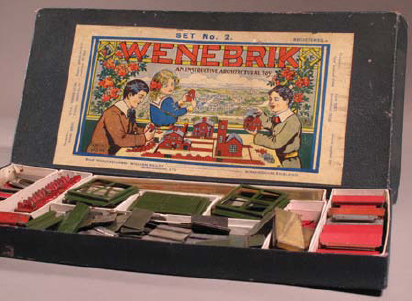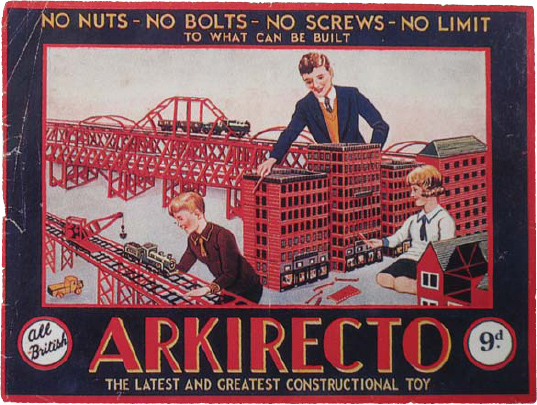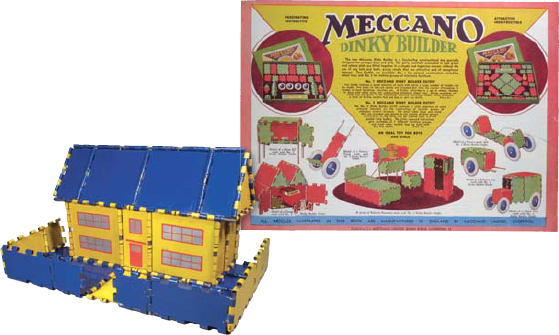BUILDING TOYS
BAYKO AND OTHER SYSTEMS
Brian Salter
SHIRE PUBLICATIONS
CONTENTS
EARLY VARIETY
Even the box of the Goodtoy set is steel. Many of the construction ideas shown are merely faades, and to this end some interior panels are provided. Full buildings above a single storey can prove to be very frustrating.
E XACTLY when children started using small blocks as a building toy is lost in the mists of time. Wooden offcuts, perhaps reduced to a regular size by a local craftsman, may have been a prized possession, but for the purposes of this book the story of building toys begins with the onset of industrialisation. The ability of at least a small section of the population to afford such a luxury as a manufactured toy is paramount.
More than six hundred manufactured systems of building toy have been identified worldwide. Many of these make use of some form of interlocking for at least a basic rigidity, but systems relying on nothing more than friction and gravity lasted much longer than might be expected. Wooden and stone pieces, representing not just bricks but columns and arches, were available from various manufacturers by the late nineteenth century. One such system, Anchor Blocks, even came to dominate the whole building-toy market for an extended period. Nonetheless, some form of interlocking is desirable, and developments aimed at achieving this seem to go just as far back. One basic method, which could be described as American log cabin, had machine-produced notched and grooved wooden pieces fitting securely together.
As the market slowly but surely expanded in the twentieth century, there was no lack of ingenuity. Thus far, building toys had been intended for constructing, and reconstructing, toy buildings, but the first major development of the new century was an engineering toy, Meccano. Produced from very humble origins by Frank Hornby, it worked, and it worked very well owing to strict manufacturing standards. It also represents one of the first uses of metal in constructional toys, and it soon had competitors.
Another of these was Kliptiko, invented by William Bailey Ltd of Birmingham in 1913. It was, and still is, referred to as the poor mans Meccano. The system used the companys expertise in sheet-metal fabrication and relied on interlocking steel tubes.
Out of the same factory came Wenebrik, an instructive architectural toy, patented in 1916. Every Wenebrik component was either painted or plated sheet steel, the slotting together of which required no small amount of pressure. Despite the risk of injury, the roof was built up with separate tiles, and there was even a complete roof gutter system, a feature only ever found on a handful of other systems anywhere. Despite being in at the start of the British building-toy industry, the firm decided in the early 1930s to concentrate on its main business.
The start of a Wenebrik house on its gold-plated bases. Included are a small stack of green roof tiles, and two different pieces of guttering. Assembly was not without its dangers, despite very careful manufacture.
There were no parts common to both Kliptiko and Wenebrik. There were no architectural parts in the Meccano system, though buildings could be constructed and even received some publicity. Another competitor, in the early 1930s, saw things differently. Arkirecto, by the firm of the same name, used a metal framework of girders, joiners and stanchions. Their architectural A sets had lithographed cladding panels, instead of gears, pulleys and wheels. The effect, particularly of the multi-storey buildings, as shown by their artwork, was very satisfactory. All sets contained a small wooden hammer to help with construction.
This girder and panel method was to reappear some twenty years later, but there are two other metal systems to be mentioned. Meccano wished to enter this market, so in 1934 they introduced Dinky Builder. This was something completely different, aimed at the younger builder. Its flat enamelled plates, held together at their curved interlocking edges by metal rods, were equally suitable for dolls house furniture or as part of simple wheeled contraptions. Providing wheels was a thoughtful act that was to be repeated many years into the future to broaden the appeal of other building sets.
Edwardian-style presentation for this Wenebrik tinplate set. The artwork of the various makes is a social history study in itself. The clothing of the young builders changes, as do the activities of the ladies, where they are present at all.
Somewhat later in date, but probably not preceding the Second World War, the Goodtoy Magnetic Construction Set adds variety. Its shallow steel tray acts both as box and building base, to which numerous small iron magnets are attracted. In their turn, some very colourful printed tin panels are brought into contact and held fairly firmly. Strangely, there are two heights of wall panel and door, therefore two scales in one box. Even more unusually, some panels are designed as interiors.
The unavailability of German-made products from 1914 onwards may have encouraged Wenebrik, Dometo and, certainly, Lotts. Although wood was a constituent of many systems worldwide, its use in this period in the United Kingdom was limited. Dometo, made by the Irish Toy Industry of Belfast, relied on wood. It had relatively simple shapes for bricks and separate roof tiles, but complex machining for corners and gutter cornices. Its large size and easy assembly made it an attractive proposition and a great step forward from the simple wooden block.
With Arkirecto, the same girder framework formed the basis of both engineering and architectural projects. This could be the first attempt at true miniature multi-storey construction. Years later, the method would reappear spectacularly.
Right: From the outset Dinky Builder tried to be all things to all men and boys and girls. This late-1934 introductory advertisement says it all architecture, transport and domestic subjects are all shown. Later, many other building systems tried similar multi-tasking techniques.
Above: At first Dinky Builder did not include doors and windows. Later they were printed on. This may be the only system where a single-storey house is not possible, or where a fully edged front path can be added.

